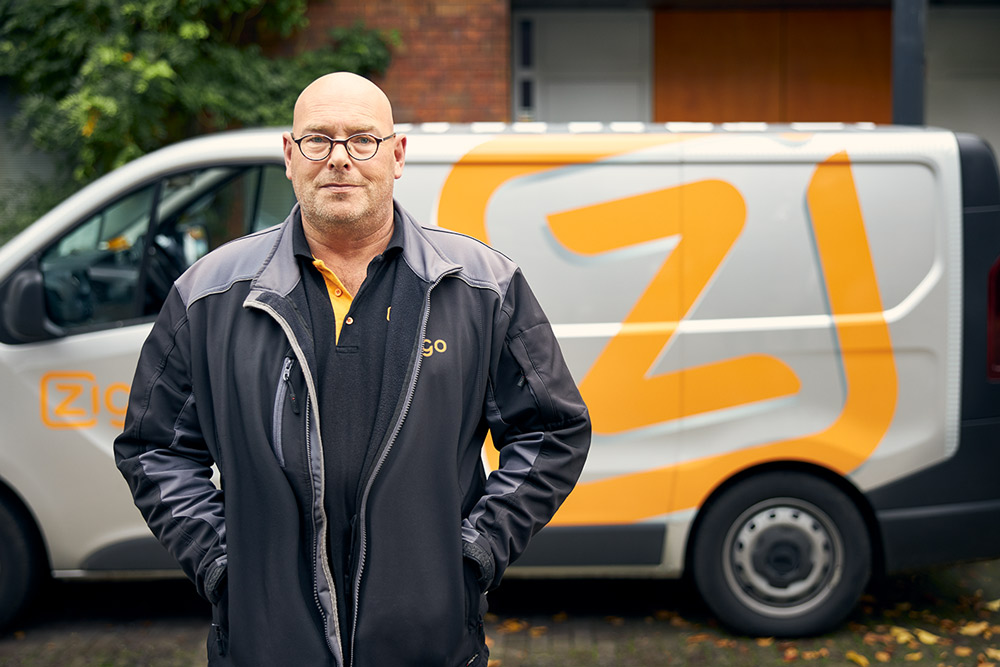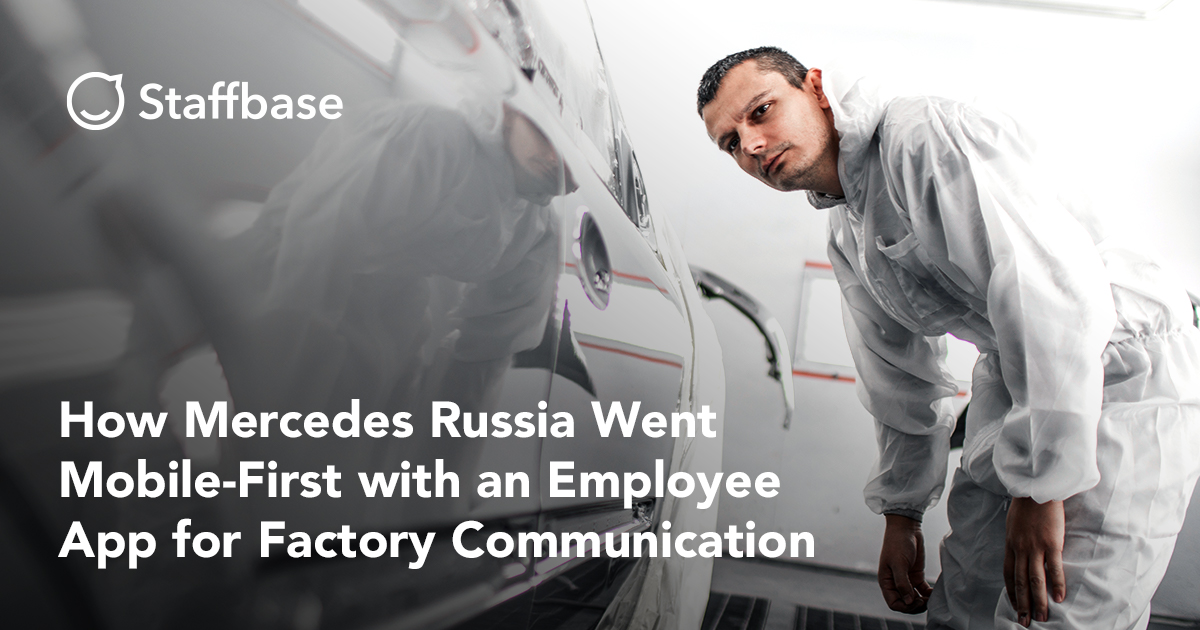As a driver of Dutch digitization, VodafoneZiggo creates valuable connections between people and for people, using the power of technology to make society stronger. The company is acutely aware that the world is becoming increasingly connected, and yet it was having problems connecting its large team of technicians spread across Holland with relevant, accurate, and authorized communication.
For lack of a better solution, these workers were forced to use multiple ad-hoc channels to communicate and share information with one another. This less-than-ideal scenario often resulted in the spread of poor information, making the job of the company’s field service techs more difficult and time-consuming. The company vowed to find a better way — and it found Staffbase.
In June 2019, VodafoneZiggo rolled out its employee app, Coco, to nearly 2,000 technicians. Six months later, their centralized, mobile-first platform has an adoption rate greater than 80 percent.
We spoke with Moustapha Benhaddou, Performance Improvement Manager, Installation & Maintenance, to find out how VodafoneZiggo came to choose the Staffbase mobile-first employee app and successfully implement this tool that workers now say they couldn’t live without.

Staffbase: Tell us a little about the problems that VodafoneZiggo was trying to solve with an employee app and how you got things rolling.
Moustapha: Sure. Before our app, which we call Coco, the way we informed and communicated with our technicians in the field was very scattered and diverse. Everyone was using his or her own method, such as Microsoft SharePoint.

One of our biggest challenges was how to get relevant information to our technicians so that they could do their work. For instance, we inform our technicians about network outages, but we also inform them when we’re launching a new product or new hardware that they’ll be working with.
The needs are very diverse for our technicians, and before Coco, they had different platforms for communicating. Some teams even created their own environments which, if you have no better way of communicating or sharing information, isn’t necessarily bad.
The downside is that they’re sharing stuff which hasn’t been validated and might not comply with company standards or regulations. That’s the risk of having information scattered everywhere.
We have technicians — either outsourced or our own — all over the Netherlands. With their different skills and tasks, getting them the right information was a huge challenge.
Staffbase: How were your employees using SharePoint?
Moustapha: Basically, they were using it as a library. For instance, if a technician wanted to find a document about the company’s Wi-Fi service policy, they could find it in their team’s SharePoint environment.
The technicians also kept track of their tips and tricks in SharePoint. These sorts of things can benefit a technician a lot, but the risk of creating these personal library-type communication platforms all over the country is that you might be sharing incorrect information.
I have no problem with people building their own solutions, they’re the ones doing the work, but within our Performance Improvement team I’m responsible for our policies and our work instructions, and I can’t live with the fact that there might be one set of work instructions with six different versions floating around all over the country. That’s unacceptable.
Staffbase: So how did you go from recognizing these sorts of challenges to coming up with a solution to meet them?
Moustapha: We have a multitude of teams, and we did a kind of roadshow with six or seven of them to get a better sense of certain problems we were facing. We asked things like, “What do you need for your work when it comes to communication? How do you want us to communicate with you? How do you want us to inform you? On what schedule? On what system should it be available? Should it be an app? Should it be your laptop? Should it be an SMS service?”
We set up what we called a “Hero Lab Session,” a workshop designed to understand how our technicians wanted us to communicate with them about everything from policies to changes, outages, information, library functionality, etc. We asked them, what do you want from us? Where do want to have it? On a PC? On a mobile phone? We wanted to understand how we could best help them.
Staffbase: So what did they say?
Moustapha: They said they wanted Coco! [laughs] Because the thing is, our technicians are constantly driving from one customer to another, or from one hub to another, and they had to use their laptops to get their next work ticket or to find out where they needed to go and what they needed to do. They were tired of having to open their laptops every time. That’s why they asked us, “Well, can we have an app?” because that’s what they’re used to.
The app is a huge timesaver. Having solutions readily available in the app helps us to solve our customers’ problems faster. When you think about the time that’s being saved per technician, per incident, it amounts to a huge savings.”
Moustapha Benhaddou, Performance Improvement Manager, Installation & Maintenance, VodafoneZiggo
Coco gives them the same experience they have with all the other apps on their phones, informing them with push notifications and everything.
Staffbase: What about Staffbase appealed to you?
Moustapha: It was the simplicity of the app. We had a live demo and it became immediately clear that we should pilot it, which we did for five months. From then on, we had an almost daily exchange with your customer success people. So we demoed the app in a test environment where we were able to start playing around with it.
Staffbase: How long did it take between deciding that Staffbase was the app for you and actually making it available to your people?
Moustapha: Well, we created one or two slides outlining all of all the benefits that we would have with the Staffbase solution, because first we had to sell it internally to our management. That was a lot easier to do since we could tell them that we could run a pilot to be completely sure that this was the right solution for our needs.
Once we set up the environment for VodafoneZiggo we selected two teams of about 100 technicians across Holland to start working with it. These people were very, very enthusiastic and positive about the app, as was our director. She talked to people in the field as well as our technicians, and she was very happy with the responses she got.

Staffbase: During your pilot were you able to measure higher productivity or fewer problems in the field for your employees?
Moustapha: Well, first of all, we wanted to create one central platform to communicate with all of our employees. We did that. Next was the goal of making accessible all of our technical documents, work instructions, blueprints, manuals — everything being used by our technicians. We did that, too.
We’re also using the app on a daily basis for sharing and collecting information from our technicians. That’s a very important thing that the app has made much easier to do. Now, when a customer contacts us with a problem that a technician can’t solve, we know in advance that it doesn’t make sense to send someone out because it will be a waste of money.
Also, in the past, when we’ve needed to understand a problem, we would normally collect one or two examples of it. With the Coco app, we can create a form and send a message asking specific teams out in the field to get information. Then we can use that information to go to our in-house engineering or our network technicians and find a faster solution for the customer.
So while I can’t measure exactly how much money all of this will save, in terms of quality and speed of solutions, the app helps us tremendously. It used to be very difficult to get information from our technicians. Now, we can instantly communicate with them directly.
Staffbase: So you’re saving both time and effort.
Moustapha: Yes. The app is a huge timesaver. Having solutions readily available in the app helps us to solve our customers’ problems faster. When you think about the time that’s being saved per technician, per incident, it amounts to a huge savings.
Also, more than half of our registered users log into Coco on a daily basis, which is incredible, especially considering we’ve only been using the app for about six months. We sent a survey to our technicians, and more than 90% of them told us that they couldn’t live without Coco.
Staffbase: That’s really great to hear.
Moustapha: There’s something else I’d like to emphasize. One of the big benefits of Coco is that we’ve created different channels within it, so we can target individual teams with specific information.
In the old days, we would send out an email to 2,000 people but it was only relevant to about 450 of them. So, what would happen? If you’re getting tons of emails every day, you’re going to start ignoring even the ones that are relevant to you.
The reason we’re growing so fast and why we have so many active daily users is because the information on Coco is relevant. I can be sure that the information Coco contains is meant for me because otherwise I wouldn’t be seeing it.
I think that’s a very important feature because it solves one of the biggest problems we had: sharing information to the relevant people.
Staffbase: It makes sense that you want to keep the content in Coco relevant to its users so that they stay engaged. That being said, do you have any ideas for how you might use Coco going forward or do you think you’ve hit a sweet spot where you’re happy to stay?
Moustapha: I think we’re really happy where we’re at. But one thing we’re looking at for the future is integration with our new collaborative field tool for our technicians. Normally, a technician uses ten, fifteen, maybe even thirty applications depending on the work he or she does. What we’ve done with the field tool is to create one GUI where information is presented based on the task at hand.
One other thing we’re hoping to figure out is how, when pushing information on Coco that’s relevant to a technician working in the field, it will also appear in our field tool so that he or she knows, “Hey, there’s a message. There’s a big outage in the area where I’m working so it doesn’t make sense to go to the next customer,” or something like that.
I’m sure if I started asking people what they would like to see in the next release of Coco they would come up with lots of ideas, but essentially we’re using this application as a centralized communication platform that shares relevant work information to all our teams. That’s the basic task of the app at the moment, and I’m not very keen on anything that might disturb this use case.
I’m sure there are some really nice integrations with other applications that would make it even more relevant to our technicians, but for now we couldn’t be happier than being right where we are.



